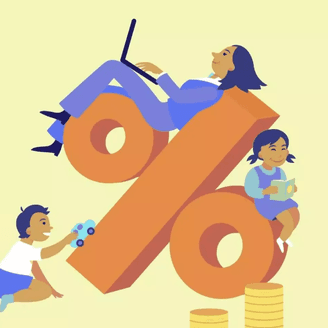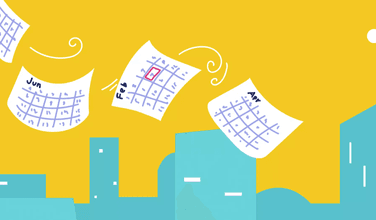- Osome Blog SG
- How Singapore Working Mothers Pay Less Tax
How Singapore Working Mothers Pay Less Tax Thanks to Child Relief
- Modified: 29 August 2024
- 9 min read
- Money Talk


Emma Drummond
Business Writer
Emma’s spent 12 years in marketing and advertising in the banking and financial sector. She tries to keep her writing fresh and convincing. One thing she loves more than writing is her cat, Bumpy.
The Inland Revenue Authority of Singapore (IRAS) provides the Working Mother’s Child Relief (WMCR) to working mothers in Singapore as a part of its personal tax relief programme.
The main purpose of WMCR relief is to give financial benefit to the families in Singapore having children who are citizens of Singapore. The programme also aims to encourage them to get Singapore citizenship for their children and wants married women with children to continue working. This article will help you as an employer, understand how your staff who are mothers can benefit from the Working Mother’s Child Relief (WMCR). If you are here to find out how the WCMR affects you as an employer, you may want to get advice from our accounting services. Otherwise, read on.
Who Qualifies for the Benefits of WMCR?
To qualify for the working mother tax relief in 2021, an individual needs to fulfill the following conditions:
- An employed mother who is either married, divorced, or widowed;
- The person earns taxable income from a job, pensions, business or trade, or through a vocation or profession.
- The person with a child who is a citizen of Singapore as of Dec 31, 2020, and meets all the conditions according to the Qualifying Child Relief (QCR) or Handicapped Child Relief (HCR).
Determining Child Order
There will be a child order that determines how much tax relief a qualifying person can claim under the WMCR programme.
The first order is in reference to the first child, and then other children. The order will be based on the following:
- A child who was born to you and your spouse or ex-spouse
- A child who was born to you and your spouse/ex-spouse before you got married to your spouse or ex-spouse
- A step-child
- A legally adopted child
How Much Tax Relief Can Be Claimed Through WMCR?
The WMCR IRAS amount is that a person will be able to claim for every child depending on the child’s order, which means the child’s birth date or legal adoption. Subsequently, IRAS matches it to a percentage of the person’s earned income.
The percentages of WMCR are combined if a mother claims the benefit for more than one child and the maximum cap is 100% of the mother's taxable income.
For example, if you have children, WMCR may lower your chargeable income by 60%. It could be a great incentive for a working mother in the workforce.
There is an income tax relief cap of S$80,000, which applies in each Year of Assessment (YA).
| First child: | 15% of mother’s earned income. |
| Second child: | 20% of mother’s earned income. |
| Third child | 25% of mother’s earned income. |
| All children thereafter: | 25% of mother’s earned income. |
Can Other Reliefs Be Claimed on the Same Child?
Married couples may qualify for other income tax child relief benefits or rebates. A working mother is eligible to claim WMCR. She can do so even if she and her husband/ex-husband has already claimed QCR/HCR on the same child. However, she has to fulfil the conditions mentioned below:
- IRAS first allows the QCR or HCR claims, regardless of whether the mother or the spouse has claimed them.
- The cumulative amount of child relief (cap) of all three tax reliefs (QCR/HCR plus WMCR) is SS$50,000 per child, and
- The WMCR benefit is limited to the remaining benefit after allowing the QCR/HCR claim.
If you are planning to claim child tax relief in Singapore, remember to update your information during the filing of your taxes on the myTaxPortal. If you have already claimed this benefit before, you do not have to worry because this section of your tax form will be auto-filled.
If you are looking for details, please visit the IRAS portal for info about various tax reliefs for parents in Singapore.
Sharing Handicapped Child Relief (HCR)
The maximum cap for HCR relief is S$7,500, and parents can agree to split the spouse relief IRAS amount.
Example
Mr and Mrs Chan are the parents of a handicapped child aged 10 years in 2020. For the Year of Assessment (YA) 2021, Mr and Mrs Chan have agreed to split the HCR of S$7,500.
According to their agreement, Mr and Mrs Chan will claim S$3,000 and S$4,500 each.
Sharing Qualifying Child Relief (QCR)
The child relief for QCR IRAS is S$4,000, which parents can share between themselves. So, if they split it S$2,000 and S$2,000, then Working Mother’s Child Relief will have S$2,000 deducted.
Example: Claiming WMCR on Children for Whom Your Spouse Has Claimed Other Child Reliefs
Mr and Mrs Lim are parents of two children. The first child has a physical disability. Mr Lim has claimed both Handicapped Child Relief (HCR) and Qualifying Child Relief (QCR) for the first and second child respectively. Mrs Lim’s earnings in 2020 were S$250,000.
Other than the Earned Income Relief amount of S$1,000 and WMCR, Mrs Lim has not claimed any other personal reliefs for the Year of Assessment 2021.
WMCR claim of Mrs Lim is below:
Child order | % of Mrs Lim's earned income [A] | Amount ($) [A] x Mrs Lim's earned income $250,000 | QCR/HCR claimed by Mr. Lim ($) | WMCR claimed by Mrs Lim ($) | Cumulative WMCR claimed by Mrs Lim ($) |
|---|---|---|---|---|---|
| 1st | 15 | 37,500 | 7,500 | 37,500 | 37,500 |
| 2nd | 20 | 50,000 | 4,000 | 46,000 | 37,500+46,000=83,500 |
Mrs Lim has claimed total personal reliefs: S$80,000
The total amount of WMCR/HCR/QCR has a cap of S$50,000 per child.
Mrs Lim’s total personal income tax relief amount is capped at S$80,000.
How To Claim (e-Filing)
Are you claiming relief for the first time?
Yes
- Login using your credentials of Singpass or Singpass Foreign user Account (SFA) at myTax Portal.
- On the portal, go to Individuals >> “File Income Tax Return”.
- Choose “Edit My Tax Form”.
- Go to the section “4.
- Deductions, Reliefs and Parenthood Tax Rebate”.Go to “Child”.
- Click “Update” and put in your claim.
No
If your relief was granted status last year, it will automatically be pre-filled and given to you this year. If you wish to make any changes to your relief, go to "Child", then click "Update" and modify your claim.
Other Tax Savings for Married Couples and Families
Parenthood Tax Rebate (PTR)
Eligible parents in Singapore qualify for the amount of Parenthood Tax Rebate (PTR):
- For the first child: S$5,000
- For the second child: S$10,000, and
- For the third and each subsequent child: S$20,000.
The parents may split the parent tax relief to reduce their payable income tax. They can also use if there is any unused rebate to reduce their payable income tax in the upcoming years until fully using the rebate.
To recognise the efforts of families for taking care of their children and those caring for their handicapped children, both mother and father can claim the IRAS parent relief amount of S$4,000 for every child according to the QCR. They can also claim S$7,500 for every child, according to the HCR.
The total WMCR/QCR and HCR amount that parents can claim as parents’ relief for every child have a cap of S$50,000. The maximum individual tax relief on income that an eligible person can claim has a cap of S$80,000.
Additionally, if employed mothers whose parent, grandparent, parent-in-law, or grandparent-in-law is taking care of any of their children aged 12 years (Singapore Citizen) and less, you can claim S$3,000 for the Grandparent Caregiver Relief (GCR).
For more details and conditions, please visit the IRAS website.
Foreign Domestic Worker Levy (FDWL) Relief
The purpose of giving the Foreign Domestic Worker Levy or FDWL is to encourage married women to continue working. Married women, divorcees, and widows with children who are in school can apply for the FDWL relief paid a year before. Men who are either single or and married do not qualify for FDWL.
To claim the FDWL relief for the Year of Assessment 2021, a person has to fulfil the following conditions:
1. A married woman or her husband has employed a foreign domestic worker in 2020
2. In 2020 she was:
- married and stayed with her husband; or
- married and her husband was not a tax-paying resident in Singapore; or
- separated from her husband, divorced or widowed, and had children who stayed with her and for whom she could claim child reliefs.
3. A married and working woman can only use the FDWL Relief to offset her earned income. Earned income is what is generated from her employment, pension, trade, business, profession, or vocation, after deducting allowable expenses.
Example
Mr Chan employed a foreign domestic worker from Oct to Dec 2020 and paid levy at the concessional rate. Mr Chan’s wife, Mrs Chan could claim the FDWL Relief of $360 for the YA 2021.
| Rate of Levy per month | $60 |
| Levy Paid in Number of Months in 2020 | 3 |
| Total Levy Payment in 2020 | $180 |
| Claimable Amount in YA 2021 | $360 ($180 x 2) |
Grandparent Caregiver Relief (GCR)
Grandparent Caregiver Relief or GCR is for employed mothers who receive the support of their parents or other relatives to care for their children. Single men or male taxpayers do not qualify for this relief.
Example
Mother-in-law is taking care of a child.
The first child of Mr and Mrs Chan was born in 2020 and was a citizen of Singapore when born. Mrs Chan is an employed mother and has taken the help of her mother-in-law for the child’s care.
In 2020, her mother-in-law was living in Singapore and was not employed or engaged in any business, trade, profession, or vocation. Additionally, no one else has claimed GCR on her mother-in-law. So, Mrs Chan can claim S$3,000 as GCR for her mother-in-law for 2021.
NSman Wife Relief
You can quality for NSman Wife Relief if:
- You are a citizen of Singapore in the previous year; and
- Your husband qualifies for NSman Self Relief.
To claim the NSman Relief:
- You must have completed your full-time National Service under the Enlistment Act (Cap. 93); or
- You are deemed to have completed such service by the proper authority.
- Regulars from MINDEF, the Singapore Police Force or the Singapore Civil Defence Force, the *Central Narcotics Bureau, the *Singapore Prison Service and NSmen who have committed any disciplinary or criminal offences in the preceding work year are excluded.
Widowed women of demised NSmen may also qualify for the relief provided they have not re-married.
The relief amount is $750. Eligible women need not apply to claim this relief since IRAS automatically grants it to them.
FAQ
I Have Filed My Tax Return for the Year of Assessment (YA) 2021. What Should I Do if I Have Forgotten to Claim or Wish to Withdraw My Claim for Working Mother’s Child Relief?
If you have filed for your tax return online.File it again within seven days of your earlier submission or by April 18, 2021, whichever is earlier. You can re-file your taxes only once.
When re-filing, you have to specify all your earning details and expenses, relief claims, and donations, as applicable. After re-filing successfully, the new submission will override the earlier one.
In the case, you went for a paper tax return or you were unable to re-file your tax return
Send an email to IRAS mentioning the details below:
- Your claim or revision request of the relief for the Year of Assessment 2021;
- Your child’s name and identification number;
- The relief amount that you want to claim or revise; andIf you meet the eligibility criteria.
Email IRAS via the myTax Mail in myTax Portal using your Singpass, IRAS Unique Account (IUA) or Corppass.
I Have Received My Tax Bill for the Year of Assessment (YA) 2021. The Amount of Working Mother’s Child Relief (WMCR) is wrong. What Should I Do?
There is a provision of filing an objection within 30 days from your tax bill date. You can use the “Objection to Assessment” e-Service in myTax Portal.
If you are not able to use the e-Service, you can email IRAS specifying the following:
- our claim or revision request of the relief for 2021;
- Your child’s name and identification number;
- The child order for claiming WMCR;
- You have fulfilled the eligibility criteria. You also need to send the certificate of Singapore Citizenship if your child was not a citizen of Singapore when born.
Email IRAS via the myTax Mail in myTax Portal using your Singpass, IRAS Unique Account (IUA) or Corppass.
What Does the Summary of Reliefs and Rebates Look Like with a Limit Cap of S$80,000?
Example
The 40-year-old Mrs Chong is the mother of three children aged 8, 10, and 12 years in 2020. She employed a foreign domestic employee in 2020 and paid levy at a reduced rate.
In 2020, Mr Chong was involved in NS activities and claimed the full relief amount of QCR on the three children.
Mrs Chong is a tax resident of Singapore and her tax calculations for YA 2021 is below:
| Earning from Employment of Mrs Chong | $120,000 |
| Less (-): Personal Reliefs | |
| Relief on Earned Income | $1,000 |
| WMCR on the first child | $18,000 ($120,000 x 15%) |
| WMCR on the second child | $24,000 ($120,000 x 20%) |
| WMCR on the third child | $30,000 ($120,000 x 25%) |
| FDWL | $1,440 ($60 x 12 months x 2 times) |
| NSman Wife Relief | $750 |
| CPF Relief | $20,400 |
| Total Amount of Personal Reliefs | $95,590 |
| Total Amount of Personal Reliefs after the cap | $80,000 |
| Chargeable Income | $40,000 ($120,000 - $80,000) |
| Tax Payable (Gross) | $550 |
| Less (-): Personal Income Tax Rebate | N/A |
| Less (-): Parenthood Tax Rebate | - * |
| Tax Payable (Net) | $550.00 |
*Mrs. Chong has used her Parenthood Tax Rebate in previous years.
Conclusion
As an employer, there are a lot of responsibilities you have towards your staff. Hiring and payroll would be one of them. If you want to further digitise your HR payroll process, check out how we are helping small to medium-sized businesses in Singapore to do so.






